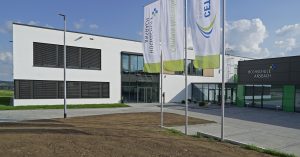
The continuous improvement process (CIP) and lean production are now being taught in universities. This interview with Professor Helmut Abels (Cologne University of Applied Sciences) highlights the role that tube systems have to play in educational institutions.
CIP and the principles of lean production have been the subject of in-depth research and have long since been integral components of courses at higher and further education institutions. However, examining the theory behind lean production methods is not enough on its own. For a two-part article, we asked Professor Helmut Abels from Cologne University of Applied Sciences about the relevant course content and methods. In the first part, we look at the use of lean production building kit systems in research and teaching, while the second part focuses on Kaizen and the lean philosop
Universities get to grips with Kaizen and lean production
Engineering students who want to know how companies keep their production efficient will also have to familiarise themselves with the theory and practice of Kaizen, the continuous improvement process and the seven Muda (types of waste). That is the only way to get to grips with the pros and cons of the various methods and be well-equipped for the future.
Forward-looking educational institutions such as Cologne University of Applied Sciences use tube systems to make sure students can get practical experience. What does it feel like to plan a production line and then work on it, too? Do the sequences work as easily as it seemed they would on paper? “The core idea of lean production that we’re establishing here is that we don’t just want to give our students a grounding in theory,” explains Professor Abels from the Faculty of Automotive Systems and Production, “they want to use all their senses to find out how it works and what steps need to be taken to get a lean factory up and running.”
Using tube systems for lean production throughout the entire production process
Students at the university learn how to build a star-shaped production system, for example, with a warehouse located in the centre to supply all the work benches arranged around it. The lean factory at Cologne UAS is ideal for training students in how to build small, effective production units.
That is made possible by our Profile Tube System D30. The entire lean factory is built from this second-generation Lean Production Building Kit System. Professor Abels takes up the story: “We looked at a lot of these tube systems and what we really liked about D30 is that it follows lean principles closely.”
That is not something that can be taken for granted, as the professor explains: “A classic element in our lean studies involves trying to tighten a long screw and then asking the students – ‘When does it start to get lean?’ and ‘When does the value creation start?’ The value creation actually only comes into play with the final tightening. It’s the same with these elements – they’re designed, so you can simply insert the tube and give it a half-turn to tighten it quickly.”
Reusable aluminium tubes as a basis
Cologne UAS also wanted a system that would be flexible and satisfy high quality standards over a long service life. Indeed, the components have to be unscrewed, reconnected and recombined over and over again. Only a very resilient tube system can meet these requirements, as Professor Abels explains: “We can build the system with the students – usually a group of around ten – in the space of half a day. It all has to move very quickly, because we want to teach the expertise behind the method. And we have to be able to dismantle everything again and again.”
The aluminium tubes in Profile Tube System D30 have proven themselves in practical applications because the Lean Production Building Kit System was developed for day-to-day use in industrial environments. “The system remains intact and suffers barely any damage,” states Professor Abels, “thanks to the fastening technology, we can use it over and over. And that is very important, particularly in a university environment.”
New ideas for lean work benches
The advantages of a building kit system for lean production become clear when practising how to extend and reconfigure structures. One typical example is switching from centralised storage to a conveyor rack storage system, which involves students having to relocate an entire unit of lean work benches into a different room.
That can only work if the building kit system can ensure fastenings are stable over the long term. “We don’t always arrive at the same solution,” points out Professor Abels, “a storage rack designed by one group might look completely different to one designed by another group. We have this flexibility in the system, which means we can reproduce what our students want to do. If we also want to incorporate future innovations, we are very well placed to do just that.”
That was the last part of our interview with Professor Abels. However, we will continue to look at the principles and development of the lean philosophy in the future. Simply subscribe to the blog – and you can rest assured you won’t miss any updates.





